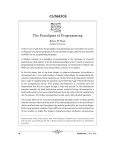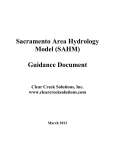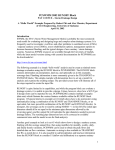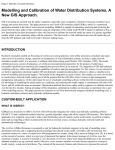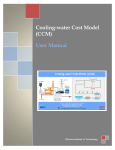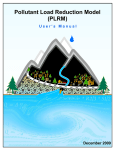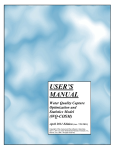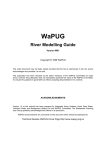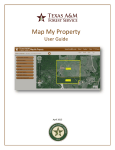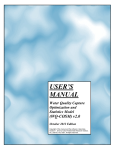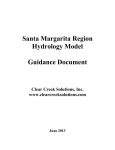Download National Stormwater Calculator User`s Guide
Transcript
EPA/600/R-13/085 | July 2013 www.epa.gov/nrmrl/wswrd/wq/models/swc/ United States Environmental Protection Agency National Stormwater Calculator User’s Guide Traditional Infrastructure Green Infrastructure Science Office of Research and Development EPA/600/R-13/085 July 2013 NATIONAL STORMWATER CALCULATOR USER’S GUIDE By Lewis A. Rossman Water Supply and Water Resources Division National Risk Management Research Laboratory Cincinnati, OH 45268 OFFICE OF RESEARCH AND DEVELOPMENT U.S. ENVIRONMENTAL PROTECTION AGENCY CINCINNATI, OH 45268 DISCLAIMER The information in this document has been funded wholly by the U.S. Environmental Protection Agency (EPA). It has been subjected to the Agency’s peer and administrative review, and has been approved for publication as an EPA document. Mention of trade names or commercial products does not constitute endorsement or recommendation for use. Although a reasonable effort has been made to assure that the results obtained are correct, the computer programs described in this manual are experimental. Therefore the author and the U.S. Environmental Protection Agency are not responsible and assume no liability whatsoever for any results or any use made of the results obtained from these programs, nor for any damages or litigation that result from the use of these programs for any purpose. ii ACKNOWLEDGEMENTS Paul Duda, Jack Kittle, and John Imhoff of Aqua Terra Consultants developed the data acquisition portions of the National Stormwater Calculator under Work Assignments 4-38 and 5-38 of EPA Contract #EP-C-06-029. Jason Berner and Tamara Mittman, both in EPA’s Office of Water (OW), were the Work Assignment Managers for that effort. They, along with Alex Foraste (EPA/OW), provided many useful ideas and feedback throughout the development of the calculator. iii ACRONYMS AND ABBREVIATIONS ASCE EPA ET GI HSG IMD Ksat LID NCDC NRCS NWS OW PET SWMM UDFCD USDA = American Society of Civil Engineers = United States Environmental Protection Agency = evapotranspiration = Green Infrastructure = Hydrologic Soil Group = initial moisture deficit = saturated hydraulic conductivity = low impact development = National Climatic Data Center = Natural Resources Conservation Service = National Weather Service = Office of Water = potential evapotranspiration = Storm Water Managment Model = Urban Drainage and Flood Control District = United States Department of Agriculture iv TABLE OF CONTENTS DISCLAIMER ............................................................................................................................................ ii ACKNOWLEDGEMENTS........................................................................................................................... iii ACRONYMS AND ABBREVIATIONS .......................................................................................................... iv TABLE OF CONTENTS ............................................................................................................................... v LIST OF FIGURES ..................................................................................................................................... vi LIST OF TABLES ...................................................................................................................................... vii 1. Introduction ........................................................................................................................................ 1 2. How to Run the Calculator ................................................................................................................... 3 Location .............................................................................................................................................. 4 Soil Type .............................................................................................................................................. 6 Soil Drainage ....................................................................................................................................... 8 Topography ......................................................................................................................................... 9 Precipitation ...................................................................................................................................... 10 Evaporation ....................................................................................................................................... 11 Land Cover ........................................................................................................................................ 13 LID Controls....................................................................................................................................... 14 Runoff ............................................................................................................................................... 15 3. Interpreting the Calculator’s Results .................................................................................................. 18 Summary Results ............................................................................................................................... 18 Rainfall Percentiles ............................................................................................................................ 19 Rainfall/Runoff .................................................................................................................................. 21 Runoff Frequency .............................................................................................................................. 23 Retention Frequency ......................................................................................................................... 23 Printing Output Results...................................................................................................................... 24 4. Applying LID Controls......................................................................................................................... 25 5. Example Application .......................................................................................................................... 29 Pre-Development Conditions ............................................................................................................. 29 Post-Development Conditions ........................................................................................................... 32 Post-Development with LID Practices ................................................................................................ 34 v 6. Computational Methods .................................................................................................................... 40 SWMM’s Runoff Model ..................................................................................................................... 40 SWMM’s LID Model ........................................................................................................................... 41 Site Model without LID Controls ........................................................................................................ 43 Site Model with LID Controls.............................................................................................................. 46 Precipitation Data.............................................................................................................................. 47 Evaporation Data ............................................................................................................................... 48 Post-Processing ................................................................................................................................. 49 7. References......................................................................................................................................... 51 LIST OF FIGURES Figure 1. The calculator’s main window. .................................................................................................. 3 Figure 2. The calculator’s Location page. ................................................................................................. 5 Figure 3. The site of Figure 2 shown in a zoomed-in bird’s eye view with a bounding circle...................... 6 Figure 4. The calculator’s Soil Type page. ................................................................................................. 7 Figure 5. The calculator’s Soil Drainage page. .......................................................................................... 9 Figure 6. The calculator’s Topography page. .......................................................................................... 10 Figure 7. The calculator’s Precipitation page. ......................................................................................... 11 Figure 8. The calculator’s Evaporation page. .......................................................................................... 12 Figure 9. The calculator’s Land Cover page. ........................................................................................... 13 Figure 10. The calculator’s LID Controls page. ........................................................................................ 15 Figure 11. The calculator’s Runoff page. ................................................................................................ 16 Figure 12. Summary results produced by the calculator. ........................................................................ 18 Figure 13. The Rainfall Percentiles plot produced by the calculator........................................................ 20 Figure 14. The Rainfall/Runoff scatter plot produced by the calculator. ................................................. 21 Figure 15. Zoomed-in portion of the Rainfall/Runoff plot of Figure 14. .................................................. 22 Figure 16. The Runoff Frequency plot produced by the calculator.......................................................... 23 Figure 17. The Retention Frequency plot produced by the calculator. .................................................... 24 Figure 18. Example of a LID Design dialog for a street planter. ............................................................... 27 Figure 19. Daily rainfall – runoff for pre-development conditions on the example site. .......................... 30 Figure 20. Runoff for different size rainfall events for the pre-developed example site. ......................... 31 Figure 21. Retention volume under pre-development conditions for the example site........................... 31 Figure 22. Daily runoff frequency for pre-development (Baseline Scenario) and post- development (Current Scenario) conditions. ............................................................................................................... 33 Figure 23. Retention frequency for pre-development (Baseline Scenario) and post-development (Current Scenario) conditions. ............................................................................................................................. 34 Figure 24. Low Impact Development controls applied to the example site. ............................................ 35 vi Figure 25. Design parameters for Rain Harvesting and Rain Garden controls. ........................................ 36 Figure 26. Design parameters for the Infiltration Basin and Porous Pavement controls. ......................... 37 Figure 27. Daily runoff frequency curves for pre-development (Baseline Scenario) and post-development with LID controls (Current Scenario) conditions. .................................................................................... 38 Figure 28. Contribution to total runoff by different magnitude storms for pre-development (Baseline Scenario) and post-development with LID controls (Current Scenario)................................................... 39 Figure 29. Retention frequency plots under pre-development (Baseline Scenario) and post-development with LID controls (Current Scenario) conditions. .................................................................................... 39 Figure 30. Conceptual representation of a bio-retention cell. ................................................................ 41 Figure 31. Locations of NWS precipitation stations available to the calculator ....................................... 48 Figure 32. Locations with computed Penman-Monteith potential evapotranspiration ........................... 49 LIST OF TABLES Table 1. Definitions of Hydrologic Soil Groups (USDA, 2010). ................................................................... 8 Table 2. Descriptions of LID practices included in the calculator............................................................. 26 Table 3. Editable LID parameters ........................................................................................................... 28 Table 4. Void space values of LID media................................................................................................. 28 Table 5. Land cover for the example site................................................................................................ 32 Table 6. Comparison of runoff statistics for post-development (Current Scenario) and pre-development (Baseline Scenario) conditions. .............................................................................................................. 33 Table 7. Runoff statistics for pre-development (Baseline Scenario) and post-development with LID controls (Current Scenario) conditions................................................................................................... 38 Table 8. Depression storage depths for different land covers................................................................. 44 Table 9. Roughness coefficients for different land covers....................................................................... 45 Table 10. Infiltration parameters. .......................................................................................................... 45 vii 1. Introduction The National Stormwater Calculator is a simple to use tool for computing small site hydrology for any location within the US. It estimates the amount of stormwater runoff generated from a site under different development and control scenarios over a long term period of historical rainfall. The analysis takes into account local soil conditions, slope, land cover and meteorology. Different types of low impact development (LID) practices (also known as green infrastructure) can be employed to help capture and retain rainfall on-site. The calculator’s primary focus is informing site developers and property owners on how well they can meet a desired stormwater retention target. It can be used to answer questions such as the following: · · · What is the largest daily rainfall amount that can be captured by a site in either its predevelopment, current, or post-development condition? To what degree will storms of different magnitudes be captured on site? What mix of LID controls can be deployed to meet a given stormwater retention target? The calculator seamlessly accesses several national databases to provide local soil and meteorological data for a site. The user supplies land cover information that reflects the state of development they wish to analyze and selects a mix of LID controls to be applied. After this information is provided, the site’s hydrologic response to a long-term record of historical hourly precipitation is computed. This allows a full range of meteorological conditions to be analyzed, rather than just a single design storm event. The resulting time series of rainfall and runoff are aggregated into daily amounts that are then used to report various runoff and retention statistics. The calculator uses the EPA Storm Water Management Model (SWMM) as its computational engine (http://www.epa.gov/nrmrl/wswrd/wq/models/swmm/). SWMM is a well established, EPA developed model that has seen continuous use and periodic updates for 40 years. Its hydrology component uses physically meaningful parameters making it especially well-suited for application on a nation-wide scale. SWMM is set up and run in the background without requiring any involvement of the user. The calculator is most appropriate for performing screening level analysis of small footprint sites up to several dozen acres in size with uniform soil conditions. The hydrological processes simulated by the calculator include evaporation of rainfall captured on vegetative surfaces or in surface depressions, infiltration losses into the soil, and overland surface flow. No attempt is made to further account for the fate of infiltrated water that might eventually transpire through vegetation or re-emerge as surface water in drainage channels or streams. The calculator, like any model, estimates an outcome based on available information such as soil type, landscape and land-use information, and historical weather. These estimates can be affected by 1 limitations on site-specific information and uncertainties about future climate. 1 To better inform decisions, it is recommended that the user develop a range of results with various assumptions about model inputs such as percent of impervious surface, soil type, and sizing of green infrastructure. An update to the SWC, which will include the ability to link to several future climate scenarios, will be released by the end of 2013. Climate projections indicate that heavy precipitation events are very likely to become more frequent as the climate changes. Green Infrastructure can increase the resiliency of stormwater management approaches to a changing climate, and this update will allow users to consider how runoff may vary based both on historical weather and potential future climate. Please check with local authorities about whether and how use of these tools may support local stormwater management goals and requirements. The remaining sections of this guide discuss how to install the calculator, how to run it, and how to interpret its output. An example application is presented showing how the calculator can be used to analyze questions related to stormwater runoff, retention, and control. Finally, a technical description is given of how the calculator performs its computations and where it obtains the parameters needed to do so. 1 One of the clearest precipitation trends in the United States is the increasing frequency and intensity of heavy downpours. The amount of rain falling in the heaviest downpours has increased approximately 20 percent on average in the past century and this trend is very likely to increase. Climate models project continued increases in the heaviest downpours during this century, while the lightest precipitation is projected to decrease. Heavy downpours that are now 1-in-20-year occurrences are projected to occur about every 4 to 15 years by the end of this century, depending on location, and the intensity of heavy downpours is also expected to increase. (Citation: Global Climate Change Impacts in the United States, Thomas R. Karl, Jerry M. Melillo, and Thomas C. Peterson (eds.). Cambridge University Press, 2009.) 2 2. How to Run the Calculator The Stormwater Calculator is a desktop application that runs on any version of Microsoft Windows with version 4 or higher of the .Net Framework installed. The program is deployed to a user’s local desktop directly from the following web page: http://www.epa.gov/nrmrl/wswrd/wq/models/swc/. After loading the page into your web browser, click the Run Calculator link to begin using the calculator. Once the calculator has been installed, there will be a folder named “US EPA” added to your Windows Start Menu. The folder contains a shortcut named “EPA Stormwater Calculator” that can be used to launch the program in the future. NOTE: You must have an internet connection to run the Stormwater Calculator. The main window of the calculator is displayed in Figure 1. It uses a series of tabbed pages to collect information about the site being analyzed and to run and view hydrologic results. A Bing Maps display allows you to view the site’s location, its topography, selected soil properties and the locations of nearby rain gages and weather stations. Figure 1. The calculator’s main window. 3 The various pages of the calculator are used as follows: Location page - establishes the site’s location Soil Type page - identifies the site’s soil type Soil Drainage page - specifies how quickly the site’s soil drains Topography page - characterizes the site’s surface topography Precipitation page - selects a nearby rain gage to supply hourly rainfall data Evaporation page - selects a nearby weather station to supply evaporation rates Land Cover page - specifies the site’s land cover for the scenario being analyzed LID Controls page - selects a set of LID control options, along with their design features, to deploy within the site 9. Runoff page - runs a long term hydrologic analysis and displays the results. 1. 2. 3. 4. 5. 6. 7. 8. There are also three command options shown along the bottom status bar that can be selected at any time: 1. Analyze a New Site: This command will discard all previously entered data and take you to the Location page where you can begin selecting a new site to analyze. You will first be prompted to save the data you entered for the current site. 2. Save Current Site: This command is used to save the information you have entered for the current site to a disk file. This file can then be re-opened in a future session of the calculator by selecting the Open a previously saved site command on the Location page. 3. Exit: This command closes down the calculator. You will be prompted to save the data you entered for the current site. You can move back and forth between the calculator’s pages to modify your selections. Most of the pages have a Help command that will display additional information about the page when selected. After an analysis has been completed on the Runoff page, you can choose to designate it as a “baseline” scenario, which means that its results will be displayed side-by-side with those of any additional scenarios that you choose to analyze. Each of the calculator’s pages will now be described in more detail. Location The Location page of the calculator is shown in Figure 2. You are asked to identify where in the U.S. the site is located. This information is used to access national soils and meteorological databases. It has an address lookup feature that allows you to easily navigate to the site’s location. You can enter an address or zip code in the Search box and either click on the Search icon, or press the Enter key to move the map view to that location. You can also use the map’s pan and zoom controls to hone in on a particular area. Once the site has been located somewhere within the map’s viewport, move the mouse pointer over the site and then left-click the mouse to mark its exact location with a red square. 4 Figure 2. The calculator’s Location page. The map display can be toggled between a standard road map view and a bird’s eye aerial view. Figure 3 shows the site located in Figure 2 with a zoomed-in aerial view selected. You can also specify the area of the site, which will result in a bounding red circle being drawn on the map. This is optional since the calculator makes all of its computations on a per unit area basis. You can also click on Open a previously saved site to read in data for a site that was previously saved to a file. (Every time you begin analyzing a new site or exit the program the calculator asks if you want to save the current site to a file.) Once you open a previously saved site, the calculator will be populated with its data. 5 Figure 3. The site of Figure 2 shown in a zoomed-in bird’s eye view with a bounding circle. Soil Type Figure 4 shows the Soil Type page of the calculator, which is used to identify the type of soil present on the site. Soil type is represented by its Hydrologic Soil Group (HSG). This is a classification used by soil scientists to characterize the physical nature and runoff potential of a soil. The calculator uses a site's soil group to infer its infiltration properties. Table 1 lists the definitions of the different soil groups. You can select a soil type based on local knowledge or by retrieving a soil map overlay from the U.S. Department of Agriculture’s Natural Resources Conservation Service (NRCS) SSURGO database (http://soils.usda.gov/survey/geography/ssurgo/). Simply check the View Soil Survey Data box at the top of the page’s left panel to retrieve SSURGO data. (There will be a slight delay the first time that the soil data is retrieved and the color-coded overlay is drawn). Figure 4 displays the results from a SSURGO retrieval. You can then select a soil type directly from the left panel or click on a color shaded region of the map. 6 Figure 4. The calculator’s Soil Type page. The SSURGO database houses soil characterization data for most of the U.S. that have been collected over the past forty years by federal, state, and local agencies participating in the National Cooperative Soil Survey. The data are compiled by “map units” which are the boundaries that define a particular recorded soil survey. These form the irregular shaped polygon areas that are displayed in the calculator’s map pane. Soil survey data do not exist for all parts of the country, particularly in downtown core urban areas; therefore, it is possible that no data will be available for your site. In this case you will have to rely on local knowledge to designate a representative soil group. 7 Table 1. Definitions of Hydrologic Soil Groups (USDA, 2010). Group Saturated Hydraulic Conductivity (in/hr) Meaning A Low runoff potential. Soils having high infiltration rates even when thoroughly wetted and consisting chiefly of deep, well to excessively drained sands or gravels. B Soils having moderate infiltration rates when thoroughly wetted and consisting chiefly of moderately deep to deep, moderately well to well-drained soils with moderately fine to moderately coarse textures. E.g., shallow loess, sandy loam. 0.30 - 0.15 C Soils having slow infiltration rates when thoroughly wetted and consisting chiefly of soils with a layer that impedes downward movement of water, or soils with moderately fine to fine textures. E.g., clay loams, shallow sandy loam. 0.15 - 0.05 D High runoff potential. Soils having very slow infiltration rates when thoroughly wetted and consisting chiefly of clay soils with a high swelling potential, soils with a permanent high water table, soils with a clay-pan or clay layer at or near the surface, and shallow soils over nearly impervious material. 0.05 - 0.00 ³ 0.45 Soil Drainage The Soil Drainage page of the calculator (Figure 5) is used to identify how fast standing water drains into the soil. This rate, known as the “saturated hydraulic conductivity,” is arguably the most significant parameter in determining how much rainfall can be infiltrated. There are several options available for assigning a hydraulic conductivity value (in inches per hour) to the site: a) The edit box can be left blank, in which case, a default value based on the site’s soil type will be used (the default value is shown next to the edit box). b) As with soil group, conductivity values from the SSURGO database can be displayed on the map when the View Soil Survey Data checkbox is selected. Clicking the mouse on a colored region of the map will make its conductivity value appear in the edit box. c) If you have local knowledge of the site’s soil conductivity you can simply enter it directly into the edit box. This is preferred over the other two choices. 8 Figure 5. The calculator’s Soil Drainage page. It should be noted that the hydraulic conductivity values from the SSURGO database are derived from soil texture and depth to groundwater and are not field measurements. As with soil type, there may not be any soil conductivity data available for your particular location. Topography Figure 6 displays the Topography page of the calculator. Site topography, as measured by surface slope (feet of drop per 100 feet of length), affects how fast excess stormwater runs off a site. Flatter slopes results in slower runoff rates and provide more time for rainfall to infiltrate into the soil. Runoff rates are less sensitive to moderate variations in slope. Therefore the calculator uses only four categories of slope – flat (2%), moderately flat (5%), moderately steep (10%) and steep (above 15%). As with soil type and drainage rate, any available SSURGO slope data will be displayed on the map if the View Soil Survey checkbox is selected. You can use the resulting display as a guide or use local knowledge to describe the site’s topography. 9 Figure 6. The calculator’s Topography page. Precipitation The Precipitation page of the calculator is shown in Figure 7. It is used to select a National Weather Service rain gage that will supply rainfall data for the site. Rainfall is the principal driving force that produces runoff. The calculator uses a long term continuous hourly rainfall record to make sure that it can replicate the full scope of storm events that might occur. The calculator contains a catalog of over 7,000 precipitation stations from the National Weather Service’s (NWS) National Climatic Data Center (NCDC). Historical hourly rainfall data for each station have been extracted from the NCDC’s repository, screened for quality assurance, and stored on an EPA file server. As shown in Figure 7, the calculator will automatically locate the five nearest stations to the site and list their location, period of record and average annual rainfall amount. You can then choose what you consider to be the most appropriate source of rainfall data for the site. 10 Figure 7. The calculator’s Precipitation page. If the Save rainfall data … command label is clicked, a Save As dialog window will appear allowing you to save the rainfall data to a text file in case you want to use the data for some other application, such as SWMM. Each line of the file will contain the recording station identification number, the year, month, day, hour, and minute of the rainfall reading and the measured hourly rainfall intensity in inches/hour. Evaporation The Evaporation page of the calculator is displayed in Figure 8. It is used to select a weather station that will supply evaporation rates for the site. Evaporation determines how quickly the moisture retention capacity of surfaces and depression storage consumed during one storm event will be restored before the next event. 11 Figure 8. The calculator’s Evaporation page. Over 5,000 NWS weather station locations throughout the U.S. have had their daily temperature records analyzed to produce estimates of monthly average evaporation rates (i.e., twelve values for each station). These rates have been stored directly into the calculator. The calculator lists the five closest locations that appear in the table along with their period of record and annual average evaporation. Note that these are “potential” evaporation rates, not recorded values (there are only a few hundred stations across the U.S. with long term recorded evaporation data). The rates have been estimated for bare soil using the Penman-Monteith equation. More details are provided in the Methodology section of this document. As with rainfall, a Save evaporation data … command is available in case you would like to save the data to a file for use in another application. If this option is selected, the data will be written to a plain text file of your choice with the twelve monthly average rates appearing on a single line. 12 Land Cover Figure 9 displays the Land Cover page of the calculator. It is used to describe the different types of pervious land cover on the site. Infiltration of rainfall into the soil can only occur through pervious surfaces. Different types of pervious surfaces capture different amounts of rainfall on vegetation or in natural depressions, and have different surface roughness. Rougher surfaces slow down runoff flow providing more opportunity for infiltration. The remaining non-pervious site area is considered to be “directly connected impervious surfaces” (roofs, sidewalks, streets, parking lots, etc. that drain directly off-site). Disconnecting some of this area, to run onto lawns for example, is an LID option appearing on the next page of the calculator. Figure 9. The calculator’s Land Cover page. You are asked to supply the percentage of the site covered by each of four different types of pervious surfaces: 1. Forest – stands of trees with adequate brush and forested litter cover 2. Meadow – non-forested natural areas, scrub and shrub rural vegetation 13 3. Lawn – sod lawn, grass, and landscaped vegetation 4. Desert – undeveloped land in arid regions with saltbush, mesquite, and cactus vegetation You should assign land cover categories to the site that reflects the specific condition you wish to analyze: pre-development, current, or post-development. A pre-development land cover will most likely contain some mix of forest, meadow, and perhaps desert. Local stormwater regulations might provide guidance on how to select a pre-development land cover or you could use a nearby undeveloped area as an example. Viewing the site map in bird’s eye view, as shown in Figure 9, would help identify the land cover for current conditions. Post-development land cover could be determined from a project’s site development plan map. Keep in mind that total runoff volume is highly dependent on the amount of impervious area on the site while it is less sensitive to how the non-impervious area is divided between the different land cover categories. LID Controls The LID Controls page of the calculator is depicted in Figure 10. It is used to deploy low impact development (LID) controls throughout the site. These are landscaping practices designed to capture and retain stormwater generated from impervious surfaces that would otherwise run off the site. As seen in Figure 10, there are seven different types of green infrastructure (GI) LID controls available. You can elect to apply any mix of these controls by simply telling the calculator what percentage of the impervious area is treated by each type of control. Each control has been assigned a reasonable set of design parameters, but these can be modified by clicking on the name of the control. This will also allow you to automatically size the control to capture a 24-hour design storm that you specify. More details on each type of control practice, its design parameters and sizing it to retain a given design storm are provided in the LID Controls section of this users guide. Green infrastructure (GI) is a relatively new and flexible term, and it has been used differently in different contexts. However, for the purposes of EPA's efforts to implement the GI Statement of Intent, EPA intends the term GI to generally refer to systems and practices that use or mimic natural water flow processes and retain stormwater or runoff on the site where it is generated. GI can be used at a wide range of landscape scales in place of, or in addition to, more traditional stormwater control elements to support the principles of LID. 14 Figure 10. The calculator’s LID Controls page. Runoff The final page of the calculator is where a hydrologic analysis of the site is run and its results are displayed. As shown in Figure 11, you can first review the data that you entered for the site and go back to make changes if needed. At the top left of the page are three analysis options that the calculator uses to statistically analyze the site’s hydrology on both an annual and daily basis: 1. The number of years of rainfall record to analyze (moving back from the most recent year on record). 2. The event threshold, which is the minimum amount of rainfall (or runoff) that must occur over a day for that day to be counted as having rainfall (or runoff). Rainfall (or runoff) above this threshold is referred to as “observable” or “measureable”. 3. The choice to ignore consecutive wet days when compiling runoff statistics (i.e., a day with measurable rainfall must be preceded by at least two days with no rainfall for it to be counted). 15 The latter option appears in some state and local stormwater regulations as a way to exempt extreme storm events from any stormwater retention requirements. Normally, you would not want to select this option as it will produce a less realistic representation of the site’s hydrology. Although results are presented as annual and daily values, they are generated by considering the site’s response to the full history of hourly rainfall amounts. Figure 11. The calculator’s Runoff page. Below the analysis options are a set of four commands that perform the following actions: 1. Compute Runoff - runs a long term simulation of the site’s hydrology and updates the output displays with new results (it will be disabled if results are currently available and no changes have been made to the site’s data). 16 2. Use as Baseline Scenario – uses the current site data and its simulation results as a baseline against which future runs will be compared in the calculator’s output displays (this option is disabled if there are no current simulation results available). 3. Remove Baseline Scenario – removes any previously designated baseline scenario from all output displays. 4. Print Results to PDF File – writes the calculator’s results for both the current and any baseline scenario to a PDF file that can be viewed with a PDF reader at a future time. When the calculator first loads or begins to analyze a new site the following default values are assigned to the site: Soil Group: Conductivity: Surface Slope: Rainfall Station: Evaporation Station: Land Cover: LID Controls: Years to Analyze: Event Threshold: Ignore Consecutive Days: B 0.4 inches/hour 5% Nearest cataloged station Nearest cataloged station 40% Lawn, 60% impervious None 10 0.10 inches No 17 3. Interpreting the Calculator’s Results The Runoff page of the calculator (Figure 11) contains several tabbed pages that display its computed results. Before discussing what these results are it will be useful to briefly describe how the calculator derives them. After you select the Compute Runoff command, the calculator internally performs the following four operations: 1. A SWMM input file is created for the site using the information you provided to the calculator. 2. SWMM is run to generate a continuous time series of rainfall and runoff from the site at 15minute intervals for the number of years specified. 3. The 15-minute time series of rainfall and runoff are accumulated into daily values by calendar day (midnight to midnight). 4. Various statistical properties of the resulting daily rainfall and runoff values are computed. Thus, the rainfall-runoff output post-processed by the calculator are the 24-hour totals for each calendar day of the period simulated. A number of different statistical measures are derived from these data, some of which will be more relevant than others depending on the context in which the calculator is being used. Summary Results The Summary Results page is shown in Figure 12 and contains the following items: Figure 12. Summary results produced by the calculator. 18 · Average Annual Rainfall: Total rainfall (in inches) that falls on the site divided by the number of years simulated. It includes all precipitation amounts recorded by the station assigned to the site, even those that fall below the Event Threshold. · Average Annual Runoff: Total runoff (in inches) produced by the site divided by the number of years simulated. It includes all runoff amounts, even those that fall below the Event Threshold. · Percent of All Rainfall Retained: The percentage of total rainfall that does not become runoff. It is equal to 1 minus the ratio of average annual runoff to average annual rainfall multiplied by 100. · Days per Year with Rainfall: The number of days with measureable rainfall divided by the number of years simulated, i.e., the average number of days per year with rainfall above the Event Threshold. · Days per Year with Runoff: The number of days with measureable runoff divided by the number of years simulated, i.e., the average number of days per year with runoff above the Event Threshold. · Percent of Wet Days Retained: The percentage of days with measureable rainfall that do not have any measureable runoff generated. It is computed by first counting the number of days that have rainfall above the Event Threshold but runoff below it. This number is then divided by the total number of rainfall days above the threshold and multiplied by 100. · Smallest Rainfall w/ Runoff: The smallest daily rainfall that produces measureable runoff. All days with rainfall less than this amount have runoff below the threshold. · Largest Rainfall w/o Runoff: The largest daily rainfall that produces no runoff. All days with more rainfall than this will have measureable runoff. Of the wet days that lie between this depth and the smallest rainfall with runoff, some will have runoff and others will not. · Max. Retention Volume: The largest daily rainfall amount retained on site over the period of record. This includes days that produce runoff from storms that are only partly captured. Note that if the Ignore Consecutive Wet Days option is in effect then the retention statistics listed above are computed by ignoring any wet days that occur within 48 hours of one another. Rainfall Percentiles The Rainfall Percentiles page of the calculator’s runoff results is displayed in Figure 13. It shows the contribution to total site runoff made by daily rainfall amounts within different percentile intervals. There are 13 intervals displayed, each expressed as range between successively higher percentile storms. The corresponding rainfall depths for these intervals are also shown. This provides a convenient way of determining what rainfall depth corresponds to a given percentile (percentiles are listed along the bottom of the horizontal axis while their corresponding depths are listed across the top of the axis.) 19 The X-th percentile storm is the daily rainfall amount that occurs at least X percent of the time, i.e., X percent of all rainfall days will have rainfall amounts less than or equal to the percentile value. It is found by first ordering all days with rainfall above the Event Threshold from smallest to highest value. The X-th percentile is the X-th percent highest value (e.g., if there were 1000 days with observable rainfall the 85-th percentile would be 850-th value in the sorted listing of rainfall amounts). Figure 13. The Rainfall Percentiles plot produced by the calculator. As an example of how to interpret this plot, look at the bar in Figure 13 associated with the 90th to 95th percentile storm interval (daily rainfalls between 1.38 and 1.81 inches). Storms of this magnitude make up 15 percent (%) of the total runoff (for this particular site and its land cover). Note that by definition the number of events within this 5 percentile interval is 5% of the total number of daily rainfall events. 20 Rainfall/Runoff The Rainfall/Runoff page of the calculator’s runoff results (Figure 14) contains a scatter plot of the runoff produced from each measureable daily rainfall event. Events with no measureable runoff show up as points along the horizontal axis. This plot illustrates the fact that there is not always a consistent relationship between rainfall and runoff. Days with similar rainfall amounts can produce different amounts of runoff depending on how that rainfall was distributed over the day and on how much rain occurred in prior days. Figure 14. The Rainfall/Runoff scatter plot produced by the calculator. 21 Figure 15 is a zoomed-in version of the rainfall – runoff plot of Figure 14. Both the smallest event with runoff and the largest event with no runoff are highlighted in the figure. These correspond to the same statistics listed on the Summary Results page of the output display. Note: To zoom in on an area of a plot, press the left mouse button while dragging the mouse pointer across the area. To un-zoom, right-click on the plot and select Un-Zoom from the pop-up menu that appears. Figure 15. Zoomed-in portion of the Rainfall/Runoff plot of Figure 14. 22 Runoff Frequency Figure 16 illustrates the Runoff Frequency page of the calculator’s runoff results. Instead of relating runoff or retention to rainfall, it focuses solely on runoff, showing how many days per year (on average) a given depth of runoff will be exceeded. As an example, looking at Figure 16 one could expect to have four days per year where the daily total runoff exceeds 1.0 inches. This type of plot is the most complete way to characterize the hydrologic response of a site to a long term record of rainfall events. It is particularly useful in comparing a site’s hydrology between different development and control scenarios, such as determining how close a post-development condition comes to meeting predevelopment hydrology. Figure 16. The Runoff Frequency plot produced by the calculator. Retention Frequency The Retention Frequency page of the calculator’s runoff results (Figure 17) plots the frequency with which a given depth of rainfall will be retained on the site under the scenario being simulated. Retainment is defined as completely capturing all rainfall up to and including the stated target depth. As an example, if a stormwater retention standard required that the first “X” inches of rainfall be retained on site, this plot will show with what degree of reliability that standard is attained. Looking at 23 Figure 17, any retention target above 1.0 inches will only be achieved about 32% of the time (i.e., only one in three wet days will meet the target). Note that any rainfall events below the target depth that are completely captured are counted as having attained the target (e.g., a day with only 0.3 inches of rainfall will be counted towards meeting a retention target of 1.0 inches if no runoff is produced). That is why the plot tails off to the right at a constant level of 29%, which happens to be the percent of all wet days fully retained for this example (refer to the Summary Results shown in Figure 12). Figure 17. The Retention Frequency plot produced by the calculator. Printing Output Results As mentioned previously, all of the information displayed on the Runoff pages of the calculator can be written to a PDF file to provide a permanent record of the analysis made for a site. You simply select the Print Results to PDF File command in the upper left panel of the Runoff page and then enter a name for the file to which the results will be written. 24 4. Applying LID Controls LID controls are landscaping practices designed to capture and retain stormwater generated from impervious surfaces that would otherwise run off the site. The Stormwater Calculator allows you to apply a mix of seven different types of LID practices to a site. These are displayed in Table 2 along with brief descriptions of each. This particular set of GI practices was chosen because they can all be sized on the basis of just area. Two other commonly used controls, vegetative swales and infiltration trenches, are not included because their sizing depends on their actual location and length within the site, information which is beyond the scope of the calculator. Each LID practice is assigned a set of default design and sizing parameters, so to apply a particular practice to a site, you only have to specify what percentage of the site’s impervious area will be treated by the practice (see Figure 10). You can, however, modify the default settings by clicking on the name of the particular practice you wish to edit. For example, Figure 18 displays the resulting LID Design dialog window that appears when the Street Planter LID is selected. All of the LID controls have similar LID Design dialogs that contain a sketch and brief description of the LID control along with a set of edit boxes for its design parameters. The Learn More … link will open your web browser to a page that provides more detailed information about the LID practice. Table 3 lists the various parameters that can be edited with the LID Design dialogs along with their default factory setting. Arguably the most important of these is the Capture Ratio parameter. This determines the size of the control relative to the impervious area it treats. Note that because the calculator does not require that the actual area of the site be specified, all sub-areas are stated on a percentage basis. So, total impervious area is some percentage of the total site area, the area treated by a particular LID control is some percentage of the total impervious area, and the area of the LID control is some percentage of the area it treats. Pressing the Size for Design Storm button on an LID Design form will make the calculator automatically size the LID control to capture the Design Storm Depth that was entered on the LID Control page (see Figure 10). This computes a Capture Ratio (area of LID relative to area being treated) for Rain Gardens, Street Planters, Infiltration Basins, and Porous Pavement by taking the ratio of the design storm depth to the depth of available storage in the LID. For Infiltration Basins it also determines the depth that will completely drain the basin within 48 hours. For Rainwater Harvesting it calculates how many cisterns of the user-supplied size will be needed to capture the design storm. Automatic sizing is not available for Disconnection, since no storage volume is used with this practice, and for Green Roofs, since the ratio is 100% by definition. The methods used to automatically size the LID controls are described in the Computational Methods section of this guide. Note that even when sized in this fashion, a LID control might not fully capture the design storm because it may not have drained completely prior to the start of the storm or the rainfall intensity during some portion of the storm event may overwhelm its infiltration capacity. The calculator is able to capture such behavior because it continuously simulates the full range of past precipitation events. 25 Table 2. Descriptions of LID practices included in the calculator. LID Practice Description Disconnection refers to the practice of directing runoff from impervious areas, such as roofs or parking lots, onto pervious areas, such as lawns or vegetative strips, instead of directly into storm drains. Disconnection Rain harvesting systems collect runoff from rooftops and convey it to a cistern tank where it can be used for non-potable water uses and on-site infiltration. Rain Harvesting Rain Gardens are shallow depressions filled with an engineered soil mix that supports vegetative growth. They provide opportunity to store and infiltrate captured runoff and retain water for plant uptake. They are commonly used on individual home lots to capture roof runoff. Rain Gardens Green Roofs Green roofs (also known as vegetated roofs) are bioretention systems placed on roof surfaces that capture and temporarily store rainwater in a soil medium. They consist of a layered system of roofing designed to support plant growth and retain water for plant uptake while preventing ponding on the roof surface. Street Planters Street Planters are typically placed along sidewalks or parking areas. They consist of concrete boxes filled with an engineered soil that supports vegetative growth. Beneath the soil is a gravel bed that provides additional storage as the captured runoff infiltrates into the existing soil below. Infiltration basins are shallow depressions filled with grass or other natural vegetation that capture runoff from adjoining areas and allow it to infiltrate into the soil. Infiltration Basins Porous Pavement Porous Pavement systems are excavated areas filled with gravel and paved over with a porous concrete or asphalt mix or with modular porous blocks. Normally all rainfall will immediately pass through the pavement into the gravel storage layer below it where it can infiltrate at natural rates into the site's native soil. 26 Figure 18. Example of a LID Design dialog for a street planter. There are some additional points to keep in mind when applying LID controls to a site: 1. The area devoted to Disconnection, Rain Gardens, and Infiltration Basins is assumed to come from the site’s collective amount of pervious land cover while the area occupied by Green Roofs, Street Planters and Porous Pavement comes from the site’s store of impervious area. 2. Because the focus of the calculator is on maximizing a site’s stormwater retention, underdrains (slotted pipes placed in the gravel beds of Street Planter and Porous Pavement areas to help dewater the unit) are not provided for. 3. The amount of void space in the soil, gravel, and pavement used in the LID controls are listed in Table 4 below. They typically have a narrow range of acceptable values and results are not terribly sensitive to variations within this range. 27 Table 3. Editable LID parameters LID Type Disconnection Rain Harvesting Rain Gardens Green Roofs Street Planters Infiltration Basins Porous Pavement Parameter Capture Ratio Cistern Size Cistern Emptying Rate Number of Cisterns Capture Ratio Ponding Depth Soil Media Thickness Soil Media Conductivity Soil Media Thickness Soil Media Conductivity Capture Ratio Ponding Depth Soil Media Thickness Soil Media Conductivity Gravel Bed Thickness Capture Ratio Basin Depth Capture Ratio Pavement Thickness Gravel Bed Thickness Default Value 100% 100 gal 50 gal/day 4 per 1,000 sq ft 5% 6 inches 12 inches 10 inches/hour 4 inches 10 inches/hour 6% 6 inches 18 inches 10 inches/hour 12 inches 5% 6 inches 100% 4 inches 18 inches Table 4. Void space values of LID media Property Soil Media Porosity Gravel Bed Void Ratio Pavement Void Ratio LID Controls Rain Gardens, Green Roofs and Street Planters Street Planters and Porous Pavement Porous Pavement 28 Default Value 45% 75% 12% 5. Example Application An example will now be presented to show how the calculator can be used to analyze small site hydrology. The site shown earlier in Figure 3 will be used as our study area, although, because the calculator is national in scope, we could have chosen any other location just as well. It is a 12 acre environmental research facility. The baseline data for the site have already been obtained from Figures 4 through 8. These identified the site’s hydrologic soil group as B, its hydraulic conductivity as 0.108 inches/hour, its topography as moderately steep, its closest precipitation station as having an annual rainfall of 47.05 inches and its closest weather station having 72.44 inches of potential evaporation per year. We will simulate three different development scenarios (pre-development, post-development, and post-development with LID controls) to show how one can both derive and evaluate compliance with different stormwater retention standards. Pre-Development Conditions Pre-development hydrology is often cited as an ideal stormwater management goal to attain because it maintains a sustainable and ecologically balanced condition within a watershed. It is also commonly used to define specific stormwater retention standards, as will be discussed shortly. To simulate a predevelopment condition for our study area, we must identify the land cover that characterizes the site in its natural pre-developed state. If you pan the site’s map display to the left, you will observe an adjacent natural area that suggests a pre-development land cover of 90% Forest and 10% Meadow. These values are entered on the Land Cover page of the calculator (see Figure 7). For the next page of the calculator no LID Controls are selected since we are analyzing a pre-development scenario. On the final page of the calculator, we select to analyze the latest 10 years of rainfall data and to not ignore back to back storm events. Running the calculator for these conditions shows that there is an average of 69 days per year with rainfall, but only 7 of these produce measureable runoff. Of the 45.2 inches of rainfall per year, 91% is retained on site. The Rainfall/Runoff plot produced by the calculator in Figure 19, shows that it is mainly storms above 1 inch or so that produce runoff, and that the correspondence between rainfall and runoff is quite variable. 29 Figure 19. Daily rainfall – runoff for pre-development conditions on the example site. Now consider a stormwater retention standard that requires a site to capture all rainfall produced from storms up to and including the 95th percentile daily rainfall event or the rainfall that would be retained on the site in its natural pre-developed state, whichever is smaller. To identify the depth of runoff that must be retained under this standard, we first need to know what the 95th percentile rainfall depth is. This can be found from the calculator’s Rainfall Percentiles plot, which is shown in Figure 20. The 95th percentile storm corresponds to 1.81 inches. To determine the rainfall retained on the undeveloped site, we can examine the calculator’s Retention Frequency plot (see Figure 21). Because the standard attaches 95% reliability to its target rainfall, we assume that the same would hold for its retention target. From Figure 21, we see that a retention target of 1.4 inches could be met 95% of the time (i.e., of the 69 days per year on average with measureable precipitation, for 66 of those the site will retain either the entire rainfall or the first 1.4 inches, whichever is smaller). Because this is less than the 1.81 inch 95th percentile rainfall, the standard for this site would be to retain 1.4 inches. 30 Figure 20. Runoff for different size rainfall events for the pre-developed example site. Figure 21. Retention volume under pre-development conditions for the example site. 31 Post-Development Conditions Next the calculator will be used to analyze the example site’s hydrology under post-development conditions. Because we want to compare the results against those for the pre-development case, we first select the Use as Baseline Scenario option on the Runoff page of the calculator to tell it to display our pre-development results as a comparison baseline scenario in future runs. We then determine the land cover for the site in its developed state. Table 5 shows the distribution of the different land cover categories across the site. Impervious surfaces cover almost half of the total site area. Selecting the Land Cover page of the calculator, we replace the pre-development land cover with this new one (refer to Figure 9). Table 5. Land cover for the example site. Land Cover Forest Meadow Lawn Total Impervious Surfaces Roofs Parking Roads & Sidewalks % of Total Area 18 8 25 49 10 9 30 % of Impervious Area 100 20 20 60 We next move to the Runoff page and re-run the analysis. Table 6 contains the resulting comparison of summary runoff statistics between the two conditions. Figure 22 does the same for the frequency of daily runoff. Note how the developed site with no runoff controls comes nowhere close to matching pre-development hydrology. Instead of only seven days per year with measureable runoff, there are 49 and the total volume of runoff has increased almost six fold. As seen in the Retention Frequency plot of Figure 23, the 1.4 inch retention target identified earlier can only be met about 30% of the time (which consists primarily of those days where a low amount of rainfall is entirely contained on site). 32 Table 6. Comparison of runoff statistics for post-development (Current Scenario) and predevelopment (Baseline Scenario) conditions. Figure 22. Daily runoff frequency for pre-development (Baseline Scenario) and post- development (Current Scenario) conditions. 33 Figure 23. Retention frequency for pre-development (Baseline Scenario) and post-development (Current Scenario) conditions. Post-Development with LID Practices We will now add some LID practices to our example site to see how well they can make its postdevelopment hydrology more closely match that of pre-development. Returning the calculator to the LID Controls page we see there are seven types of LID controls available to apply in any combination and sizing to the impervious areas of the site. From Table 5, we see that roofs occupy 20% of the total impervious area, parking lots another 20%, and the remaining 60% is roads and sidewalks. Because the site houses a research facility, we assume that we can capture runoff from the roof of the main building (15% of the impervious area) in Cisterns and use it for non-potable purposes within the site. Runoff from the roofs, roads and parking areas on the north side of the site will be directed into an Infiltration Basin. A portion of the south parking area will be replaced with Porous Pavement. Finally, strategically placed Rain Gardens will be used to intercept runoff from the remaining roofs, roads and sidewalks. Figure 24 shows how the LID Controls practices page of the calculator was filled in to reflect these choices. A design storm size of 1.4 inches, based on the retention standard derived earlier, was chosen to automatically size each LID control. Each LID’s design dialog was launched to apply automatic sizing to it. The results of this process are shown in Figures 25 and 26 (Capture Ratios for the infiltration basin, rain gardens and porous pavement; number of cisterns / 1,000 square feet for rain harvesting). 34 Figure 24. Low Impact Development controls applied to the example site. Re-running the calculator for the developed site with LID controls produces the summary results shown in Table 7. The site now comes much closer to matching the pre-development hydrology. With LID controls the developed site has only one more day per year, on average, with runoff than does the undeveloped site and about the same total annual runoff. Figure 27 shows that the controlled site has almost the same runoff frequency curve as the pre-developed site. Figure 28 shows an almost identical contribution of different size storms to runoff between the two. Finally, from Figure 29 we see that with this extensive use of LID controls the site could meet the 1.4 inch retention standard 94% of the time reliability which is quite close to the 95% goal. This slight shortfall can be attributed to the approximation inherent in using a fixed design storm to size the LID controls while evaluating their performance over a full range of meteorological conditions. 35 Figure 25. Design parameters for Rain Harvesting and Rain Garden controls. 36 Figure 26. Design parameters for the Infiltration Basin and Porous Pavement controls. 37 Table 7. Runoff statistics for pre-development (Baseline Scenario) and postdevelopment with LID controls (Current Scenario) conditions. Figure 27. Daily runoff frequency curves for pre-development (Baseline Scenario) and post-development with LID controls (Current Scenario) conditions. 38 Figure 28. Contribution to total runoff by different magnitude storms for pre-development (Baseline Scenario) and post-development with LID controls (Current Scenario). Figure 29. Retention frequency plots under pre-development (Baseline Scenario) and post-development with LID controls (Current Scenario) conditions. 39 6. Computational Methods The National Stormwater Calculator uses SWMM 5 (EPA, 2010) as its computational engine. SWMM is a comprehensive model that addresses surface runoff, infiltration, groundwater, snow melt, stormwater detention, and full dynamic wave flow routing within any configuration of open and closed channels. Only its runoff, infiltration, and LID sub-models are used by the calculator. This section describes how SWMM carries out its hydrology calculations, how the calculator sets up a SWMM model for the site being analyzed, how it populates the parameter values needed to run the model, and how it postprocesses the results produced by SWMM. SWMM’s Runoff Model SWMM allows a study area to be subdivided into any number of irregularly shaped subcatchment areas to best capture the effect that spatial variability in topography, drainage pathways, land cover, and soil characteristics have on runoff generation. An idealized subcatchment is conceptualized as a rectangular surface that has a uniform slope and drains to a single outlet point or channel or to another subcatchment. Each subcatchment can be further divided into three subareas: an impervious area with depression (detention) storage, an impervious area without depression storage and a pervious area with depression storage. Only the latter area allows for rainfall losses due to infiltration into the soil. SWMM uses a nonlinear reservoir model to estimate surface runoff produced by rainfall over each subarea of a subcatchment (Chen and Shubinski 1971). From conservation of mass, the net change in depth per unit of time of water stored on the land surface is simply the difference between inflow and outflow rates over the subcatchment: (1) where d = depth of water on the land surface, i = rate of rainfall + any runon from upstream subcatchments, e = evaporation rate, f = soil infiltration rate, q = runoff rate and t = time. Note that the fluxes i, e, f, and q are expressed as flow rates per unit area. By assuming that the overland flow across the sub-area’s width is normal, the Manning equation can be used to express the runoff rate q as: (2) where W = width of the subcatchment’s outflow face, S = subcatchment slope, n = roughness coefficient, A = subcatchment area and d s = depression storage depth. The latter represents initial rainfall abstractions such as surface ponding, interception by vegetation, and surface wetting. Note that no runoff occurs when d is below d s . How the calculator sets values for the parameters in this equation is discussed on page 49. Substituting (2) into (1) produces an ordinary non-linear differential equation that can be solved numerically for d over a sequence of discrete time steps given externally imposed rainfall and 40 evaporation rates and a computed infiltration rate f. By knowing d, (2) can be evaluated to determine the runoff q at each time step. SWMM 5 offers a choice of three different methods for computing soil infiltration rates – the Horton, Green-Ampt and Curve Number models. The Green-Ampt method was chosen for use in the calculator because it is based on physical parameters that can be related to the site’s soil type. SWMM uses the well-known Mein-Larson form of this model (Mein and Larson, 1973): (3) where K s = saturated hydraulic conductivity, f = soil porosity, q 0 = initial soil moisture content, y = suction head at the wetting front, and F = cumulative infiltration volume. Equation (3) applies after a sufficient time has elapsed to saturate the top layer of soil. During wet periods the moisture content of where L u is the layer depth equal to the uppermost layer of soil increases at a rate of (for L u in inches and K s in in/hr). During dry periods the moisture content decreases at a rate of k r q 0 where the rate constant k r is estimated as . At the start of the next wet period q 0 is set equal to the current moisture content. SWMM’s LID Model SWMM 5 has been extended to explicitly model several types of LID practices (Rossman, 2009). Consider a typical bio-retention cell in the form of a street planter as shown in the left panel of Figure 30. Conceptually it can be represented by a series of three horizontal layers as depicted in the figure’s right panel. Figure 30. Conceptual representation of a bio-retention cell. 41 The surface layer receives both direct rainfall and runon from other areas. It loses water through infiltration into the soil layer below it, by evapotranspiration (ET) of any water stored in depression storage and vegetative capture, and by any surface runoff that might occur. The soil layer contains an amended soil mix that can support vegetative growth. It receives infiltration from the surface layer and loses water through ET and by percolation into the storage layer below it. The storage layer consists of coarse crushed stone or gravel. It receives percolation from the soil zone above it and loses water by either infiltration into the underlying natural soil or by outflow through a perforated pipe under drain system. The hydrologic performance of this LID unit can be modeled by solving the mass balance equations that express the change in water volume in each layer over time as the difference between the inflow water flux rate and the outflow flux rate. The equations for the surface layer, soil layer, and storage layer can be written as (4) (5) (6) respectively, where d 1 = depth of ponded surface water, q 2 = soil layer moisture content, d 3 = depth of water in the storage layer, i = rainfall rate, q 0 = upstream runon rate, q 1 = surface runoff flow rate, q 3 = underdrain outflow rate, e 1 = surface ET rate, e 2 = soil zone ET rate, f 1 = surface infiltration rate, f 2 = soil percolation rate, f 3 = native soil infiltration rate, L 2 = depth of the soil layer, and f3 = porosity of the storage layer. The flux terms (q, e, and f) in these equations are functions of the current water content in the various layers (d 1 , q 2 , and d 3 ) and specific site and soil characteristics. The surface and native infiltration rates are determined using the Green-Ampt model. The soil percolation rate decreases exponentially from K s with decreasing soil moisture: where ρ is a percolation constant typically in the range of 5 to 15. Under drain outflow rate is modeled as a power function of head of water above the drain outlet: distance of the drain from the bottom of the unit. where α and β are constants and d d is the offset This set of equations can be solved numerically at each runoff time step to determine how an inflow hydrograph to the LID unit is converted into some combination of runoff hydrograph, sub-surface storage, sub-surface drainage, and infiltration into the surrounding native soil. In addition to Street Planters and Green Roofs, the bio-retention model just described can be used to represent Rain Gardens by eliminating the storage layer and also Porous Pavement systems by replacing the soil layer with a pavement layer. 42 Site Model without LID Controls To analyze a site’s hydrology without any LID controls, the calculator creates a single SWMM subcatchment object and populates it with the following parameter values: Site Area: A nominal area of 10 acres is used. As mentioned earlier, because all results are expressed per unit of area, there is no need to use an actual site area. Width: This is the width of the outflow face of a conceptual rectangular plane over which runoff flows. In most SWMM models, it is initially set to the site area divided by the length of the overland flow path that runoff follows, and is then refined by calibration against measured runoff hydrographs. When assigning an overland flow path length, particularly for sites with natural land cover, one must recognize that there is a maximum distance over which true sheet flow prevails. Beyond this, runoff consolidates into rivulet flow with much faster travel times and less opportunity for infiltration. There is no general agreement on what distance should be used as a maximum overland flow path length. The NRCS recommends a maximum length of 100 ft (USDA, 2010), while Denver’s Urban Drainage and Flood Control District uses a maximum of 500 ft. (UDFCD, 2007). For the calculator, a conservative value of 150 ft is used. The resulting width parameter for the SWMM input file is therefore set to the nominal area (10 acres) divided by this length. Slope: A value of 2% is used for flat slopes, 5% for moderately flat slopes, 10% for moderately steep slopes, and 20% for steep slopes. Percent Impervious: SWMM only considers two types of land surfaces – impervious and pervious – each with its own depression storage depth and surface roughness parameters. It does not explicitly consider the different types of land covers that comprise these two categories and how their characteristics affect depression storage and roughness. Impervious surfaces, such as roads, roofs, sidewalks, and parking lots show minor variation in these parameters; it is therefore acceptable to treat them as a single category. To provide more refinement in characterizing pervious areas, the calculator allows the user to specify the percentage of the site’s area devoted to four different sub-categories of land surface cover: Forest, Meadow, Lawn, and Desert. These sub-categories were chosen from a distillation of categories used in the Western Washington Hydrology Model (Clear Creek Solutions, Inc, 2006) and the National Green Values Calculator (Center for Neighborhood Technology, 2009). The remaining area is assigned as Impervious Cover. 43 Depression Storage Depth: Depression storage corresponds to a depth that must be filled prior to the occurrence of any runoff. It represents initial abstractions such as surface ponding, interception by flat roofs and vegetation, and surface wetting. Separate values are supplied for the pervious and impervious areas of a catchment. Depression storage for impervious surfaces is relatively small, ranging from 0.05 to 0.1 inches (ASCE, 1992). For the remaining pervious area, the calculator uses an area-weighted average of the storages associated with each type of pervious land surface that covers the site. Table 8 contains depression storage depths that have been suggested by different organizations for each land cover category. The last column contains the value used in the calculator. Table 8. Depression storage depths for different land covers. Land Cover ASCE (1992) UDFCD (2006) USDA (2010)a Calculator 0.53 0.40 Forest 0.3 Meadow 0.2 0.4 0.56 0.30 0.1 – 0.2 0.35 0.50 0.20 0.27 0.25 0.04 0.05 Lawn Desert Impervious 0.05 – 0.1 0.05 – 0.1 a Set equal to the initial abstraction computed for the land cover’s Curve Number and a Group D soil (to minimize any contribution from infiltration). Roughness Coefficient: The roughness coefficient reflects the amount of resistance that overland flow encounters as it runs off of the land surface. SWMM uses separate values for the impervious and pervious areas of a catchment. Table 9 lists roughness coefficients published by several different sources for each land cover category, along with those selected for use in the calculator. The value presented to SWMM, as representative of the site’s pervious area, is the area-weighted average of the roughness for each land cover category. Percent of Impervious Area without Depression Storage: This parameter accounts for immediate runoff that occurs at the beginning of rainfall before depression storage is satisfied, caused by impervious areas immediately adjacent to storm drains. The calculator assumes a value of 0 to give a maximum credit to the small amount of depression storage used for impervious surfaces. 44 Table 9. Roughness coefficients for different land covers. SWMa Land Cover Forest Engmanb Yenc Calculator 0.06 – 0.12 0.40 0.01 – 0.32 0.04 – 0.18 0.20 0.3 – 0.63 0.03 – 0.12 0.30 0.032 – 0.045 0.04 0.01 – 0.025 0.01 0.4 Meadow Lawn 0.2 – 0.35 Desert Impervious 0.01 -0.014 0.01 – 0.013 a Stanford Watershed Model (Crawford and Linsley, 1966) Engman (1986) c Yen (2001) b Infiltration Parameters: There are three parameters required by the Green-Ampt infiltration model used in the calculator: Saturated Hydraulic Conductivity (Ksat) - the rate at which water will infiltrate through a completely saturated soil. 2. Suction Head (y) - capillary tension (force at which water is held within soil pores) at the infiltration wetting front. 3. Initial Moisture Deficit (IMD) – the difference in moisture content between a completely wet and completely dry (or drained) soil (i.e., the difference between the soil’s porosity and its field capacity) Values for these parameters can be assigned based on soil group. Using the NRCS’s definitions (USDA, 2010), an A soil is mostly sand, a B soil is typical of a sandy loam, a C soil is like a clay loam, and a D soil is mostly clay. Table 10 lists the average values of Ksat, y, and IMD for these four soil types from measurements made from roughly 5,000 soils (of all types) across the U.S. (Rawls et al., 1983). Also shown, are the values that were chosen for use in the calculator. Note that the calculator Ksat values are defaults. The user can also use values extracted from the SSURGO data base or enter their own sitespecific numbers. 1. Table 10. Infiltration parameters. Rawls et al. Soil Type Calculator Ksat (in/h) y (in) IMD Ksat (in/h) y (in) IMD Sand 4.6 1.95 0.38 4.0 2.0 0.38 Sandy Loam 0.43 4.33 0.26 0.4 4.3 0.26 Clay Loam 0.04 8.22 0.15 0.04 8.2 0.15 Clay 0.01 12.45 0.10 0.01 12.5 0.10 45 Site Model with LID Controls The basic SWMM model used by the calculator is extended when LID controls are applied to the site. These extensions depend on the type of LID that is deployed. Disconnection A second subcatchment is added to the model when Disconnection is employed. Its impervious area equals the fraction of the site’s total impervious area that is disconnected, while its pervious area equals the Capture Ratio times the latter area. Both of these areas are assigned the same parameters as the original subcatchment, and the latter’s areas are reduced to reflect the presence of this second subcatchment. Infiltration Basin An Infiltration Basin also adds an additional subcatchment to the model that contains the impervious area treated by the basin and no pervious area. The impervious area of the original subcatchment is reduced accordingly. This new subcatchment sends its runoff to a SWMM Storage Node, whose surface area is the Basin’s Capture Ratio times the subcatchment’s area, and whose maximum depth is the Basin Depth set by the user. The Storage Node is allowed to infiltrate water into the site’s native soil by assigning it the same Ksat value used for the site. Any runoff that exceeds the Basin’s storage capacity shows up as “flooding” in the SWMM output, and is added to the surface runoff generated from the other subcatchments in the model. Rain Harvesting This LID option is modeled in a similar fashion to an Infiltration Basin. An additional, completely impervious subcatchment is introduced, whose area is the portion of the original subcatchment impervious area that is captured by cisterns. Once again, this amount of impervious area is subtracted from that of the original subcatchment, and an additional Storage Node is introduced to represent the combined retention volume of the cisterns. It receives runoff from the added subcatchment. Its maximum depth is set to a nominal height of 48 inches. Its surface area equals the area of its contributing subcatchment times the number of cisterns per unit area (as supplied by the user) times the area per cistern. The latter is found by dividing the user-supplied volume per cistern by the nominal depth. Note that any nominal depth can be used since the area per cistern will adjust itself accordingly to maintain an equal amount of total cistern storage volume. The rate at which the cisterns empty is converted into an equivalent “infiltration” rate for the storage node, equal to the user-supplied emptying rate (in gal/day) divided by the area per cistern. As with the Infiltration Basin, when the cisterns become full, any overflow shows up as node flooding in SWMM, which gets added to the runoff from other portions of the site. Other LID Controls Rain Gardens, Green Roofs, Street Planters, and Porous Pavement do not require additional subcatchments – they are all placed within the original subcatchment used to model the site. The original pervious area of this subcatchment is reduced by the amount of area devoted to Rain Gardens, 46 while the original impervious area is reduced by the area taken up by any Green Roofs, Street Planters and Porous Pavement. LID Sizing When the user supplies a design storm depth, the LID controls can be automatically sized to retain this depth. For Rain Harvesting, the number of cisterns required per unit area is simply the design storm depth divided by the volume of a cistern. For the other controls, the Capture Ratio (CR), which is the ratio of the LID control area to the impervious area being treated, is computed as (7) where Dstorm is the design storm depth (inches over 24 hours), Dlid is the storage depth (inches) provided by the LID control, and Ksat is the saturated hydraulic conductivity of the native soil underneath the LID control (inches/day). The 0.5 factor accounts for the average amount of infiltration occurring over the duration of the design storm. The LID storage volume consists of any ponding depth plus the depths of any soil and gravel layers times their respective void fractions. Precipitation Data The SWMM model built by the calculator includes a single Rain Gage object that provides it with hourly precipitation data. These data come from a nearby National Weather Service precipitation monitoring station as selected by the user. The calculator can access historical hourly rainfall data from some 7,000 stations that are part of the data holdings for EPA’s BASINS system (http://water.epa.gov/scitech/datait/models/basins/index.cfm). The data for each station is contained in its own file on an EPA server, which is downloaded and made available to the calculator. The national coverage provided by these stations is shown in Figure 31. 47 Figure 31. Locations of NWS precipitation stations available to the calculator (Alaska and Hawaii not shown). Evaporation Data The BASINS holdings only include 329 stations with measured evaporation data more recent than January 1, 2000 and at least a 5-year period of record. About 200 of the observed evaporation stations appear to have missing data for some months of the year. Because of this sparseness of measured evaporation, it was decided to generate evaporation values using daily temperature data from 5,233 weather stations across the U.S. which also measured hourly precipitation. The Penman-Monteith algorithm was extracted from the SWAT model (Neitsch et al., 2005), and used to compute daily potential evapotranspiration (PET) from daily precipitation and min/max air temperature, along with generated solar radiation, relative humidity, and wind speed. Additional details of this calculation can be found in the Quality Assurance Report produced for this project by Aqua Terra Consultants (Aqua Terra Consultants, 2011). The locations for which PET values were generated are displayed in Figure 32. The original result of these calculations was an average PET value for each day of the year (365 values) for each station. A sensitivity analysis was performed with the calculator to see what effect there would be in using a monthly average PET value instead (12 values per station). Using the monthly values produced annual runoff volumes that were only 2 to 5% different than those from the daily values. It 48 was therefore decided to use just the monthly average PET values for the calculator. Each PET location is identified by its latitude, longitude, and twelve monthly average evaporation rates that are contained in a table built into the calculator. This table is used to supply evaporation rates to the SWMM model constructed by the calculator. Figure 32. Locations with computed Penman-Monteith potential evapotranspiration (Alaska and Hawaii not shown). Post-Processing The calculator runs its site model through SWMM using a 5 minute computational time step over each year of the period of record selected by the user, and requests that SWMM use a 15 minute reporting interval for its results. SWMM writes the rainfall intensity and the runoff results it computes at this reporting interval to a binary output file. The calculator then reads this output file and aggregates rainfall and runoff into daily totals, expressed as inches, for each day of the simulation period. It also keeps track of how many previous days with no measureable rainfall occur for each day with measureable rainfall. Measureable rainfall and runoff is taken as any daily amount above the user49 supplied threshold (whose default is 0.1 inches). For days that have runoff but no rainfall, the runoff is added to that of the previous day. After the aggregation process is complete, the simulation results have been distilled down into a set of records equal in number to the number of days with measureable rainfall; where each record contains a daily rainfall, daily runoff, and number of antecedent dry days. The Summary Results report produced by the calculator (refer to Figure 12) comes from a direct inspection of the daily rainfall/runoff record. (The Maximum Retention Volume statistic is simply the largest difference between daily rainfall and its corresponding runoff among all records.) Likewise the Rainfall/Runoff plot (see Figure 14) is simply a scatter plot of the daily rainfall/runoff values. The Rainfall Percentiles plot (see Figure 13) is generated as follows: 1. The daily measureable rainfall values are sorted by size and a set of different percentile values are identified (the 10, 20, 30, 40, 50, 60, 70, 75, 80, 85, 90, 95, and 99-th percentiles). 2. The days with rainfall that fall within each percentile interval are identified, honoring the user’s choice to either include or exclude consecutive wet days. 3. The total runoff from events in each interval, as a percentage of the total runoff from all events, is computed and plotted. The Runoff Frequency plot (see Figure 16) is generated by first sorting the daily runoff values by size, ignoring consecutive rainfall days if the user selected that option. The days per year for which each runoff value is exceeded, is computed as (N – j) / Y, where N is the total number of runoff values, j is the rank order of the runoff in the sorted list, and Y is the total years simulated. Then each runoff exceedance frequency pair is plotted. The Retention Frequency plot (see Figure 17) is generated by taking the same set of rainfall percentiles used in the Rainfall Percentiles plot, only referring to them as retention volumes. For each retention volume, the percentage of daily rainfall events providing that amount of retention is computed. This is done by examining each day with observable rainfall, ignoring back to back wet days if that option was selected. If there was no measureable runoff for the day, then the count of retained events for the retention volume being analyzed is incremented. Otherwise, if the rainfall was at least as much as the target retention, and the difference between rainfall and runoff was also this much, then the count of retained events is also incremented. The retention provided for the given retention target is simply the number of retained events divided by the total number of daily events. This process is repeated for each of the thirteen pre-selected retention volumes and the resulting pairs of retention volume – retention frequency values are plotted. 50 7. References American Society of Civil Engineers (ASCE) (1992). “Design and Construction of Urban Stormwater Management Systems.” American Society of Civil Engineers, New York, NY. Aqua Terra Consultants (2011). “Quality Assurance Project Plan – Stormwater Calculator Technical Support.”EPA Contract #EP-C-06-029, Work Assignments #4-38 and 5-38. Center for Neighborhood Technology (2009). “National Stormwater Management Calculator.” <http://greenvalues.cnt.org/national/calculator.php> Chen, C.W. and Shubinski, R.P. (1971). “Computer Simulation of Urban Storm Water Runoff.” Journal of the Hydraulics Division. ASCE, 97(2):289-301. Clear Creek Solutions, Inc. (2006). “Western Washington Hydrology Model Version 3.0 User Manual.” <http://www.ecy.wa.gov/programs/wq/stormwater/wwhm_training/wwhm/wwhm_v3/index.html> Crawford, N.H. and Linsley, R.K. (1966). “Digital Simulation in Hydrology: Stanford Watershed Model IV.” Technical Report No. 39, Civil Engineering Department, Stanford University, Palo Alto, CA. Engman, E.T. (1986). “Roughness Coefficients for Routing Surface Runoff.” Journal of Irrigation and Drainage Engineering, ASCE, 112(1):39-53. Mein, R.G. and Larson, C.L. (1973). “Modeling infiltration during a steady rain.” Water Resources Research, 9(2):334-394. Neitsch S.L., J.G. Arnold, J.R. Kiniry, and J.R. Williams (2005). “Soil and Water Assessment Tool Theoretical Documentation.” Version 2005, Agricultural Research Service and Texas Agricultural Experiment Station, January 2005. Rawls, W.J., Brakensiel, D.L., and Miller, N. (1983). “Green-Ampt Infiltration Parameters from Soils Data”, Journal of Hydraulic Engineering, ASCE, Vol. 109, No. 1, 62-70. Rossman, L.A. (2009). “Modeling Low Impact Development Alternatives with SWMM.” In Dynamic Modeling of Urban Water Systems, Monograph 18, W. James, ed., CHI, Guelph, ON, Canada. Urban Drainage and Flood Control District (UDFCD) (2007). “Drainage Criteria Manual, Chapter 5 – Runoff”, Urban Drainage and Flood Control District, Denver, CO. (http://www.udfcd.org/downloads/down_critmanual_volI.htm). U.S. Department of Agriculture (USDA) (2010). “National Engineering Handbook.” Natural Resources Conservation Service, USDA, Washington, DC. U.S. Environmental Protection Agency (EPA) (2010). “Storm Water Management Model User’s Manual, Version 5.0.” U.S. Environmental Protection Agency, Washington, D.C., Pub No.EPA/600/R-05/040 (Revised 2010). 51 Yen, B.C., (2001). “Hydraulics of Sewer Systems.” Chapter 6 in Stormwater Collection Systems Design Handbook, L.M. Mays, ed., McGraw-Hill, New York. 52































































